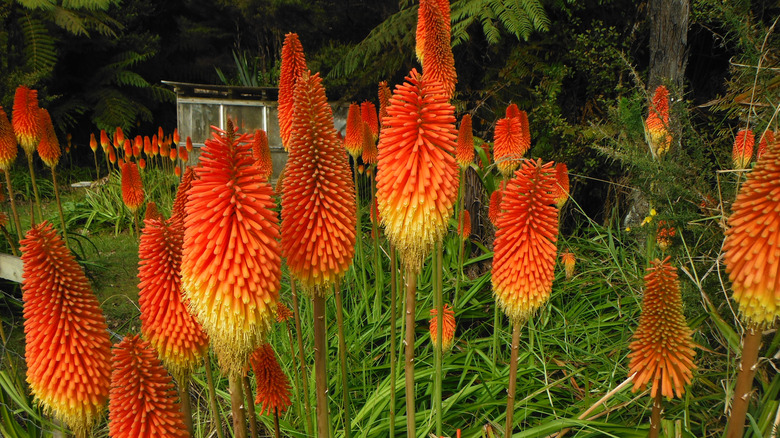Scientifically known as Kniphofia, the red hot poker plant (aka tritoma, flame flower, or torch lily) is a captivating addition to any garden, renowned for its striking appearance and ability to attract pollinators like hummingbirds, bees, and orioles. It is also drought tolerant, making it ideal for xeriscaping. This vibrant, perennial native to southern and tropical Africa has become a favorite among gardening enthusiasts.
Originating from the grasslands and rocky slopes of South Africa, Swaziland, and Lesotho, red hot poker flowers found their way to Europe in the 17th century, and were later introduced to New Zealand and North America. One of the most remarkable features of red hot poker plants is their aesthetic appeal. Their tubular, torch-like blooms boast a gradient of warm hues, transitioning from fiery red at the top to a soft yellow or cream at the base. This captivating color spectrum can add a dynamic and eye-catching element to your garden, effortlessly standing out amidst other plants. The long, slender flower spikes rise majestically above the foliage, creating a dramatic visual impact.
Beyond their visual appeal, red hot poker flowers play a crucial role in supporting local ecosystems. They serve as a rich nectar source for hummingbirds, thereby attracting these charming and lively pollinators to your garden. The tubular shape of the blooms is particularly well-suited for hummingbirds, providing easy access to the sweet nectar within. As these birds flit from flower to flower, they not only enhance your garden’s liveliness but also contribute to pollination.
Cultivating red hot poker flowers in your garden

To cultivate red hot poker flowers successfully, start by selecting a sunny location in your garden or yard. These plants thrive in full sunlight and fertile, well-draining soil. Plant them during the spring or fall, ensuring proper spacing to accommodate their maturing size. Water the plants deeply but sparingly right at the base (to prevent the growth of leaf spots), allowing the soil to dry out before the next watering cycle. Although red hot poker plants are hardy and are not heavy feeders, you may fertilize them in the spring with a balanced, slow-release fertilizer for healthy growth and to promote flowering. If you live in a cold area, you can protect red hot poker plants from winter freeze by adding a thick layer of mulch around the base during late fall.
Prune or deadhead spent flower spikes to encourage continuous blooming, and to stop them from self-seeding and becoming invasive. Remove any damaged or yellowing leaves as well. While red hot poker flowers are relatively resistant to pests, monitor your plants for thrips as well as aphid, slug, and snail invasions, and employ appropriate measures if needed. These simple steps will ensure a thriving red hot poker display in your garden, attracting both the eyes and hummingbirds alike.